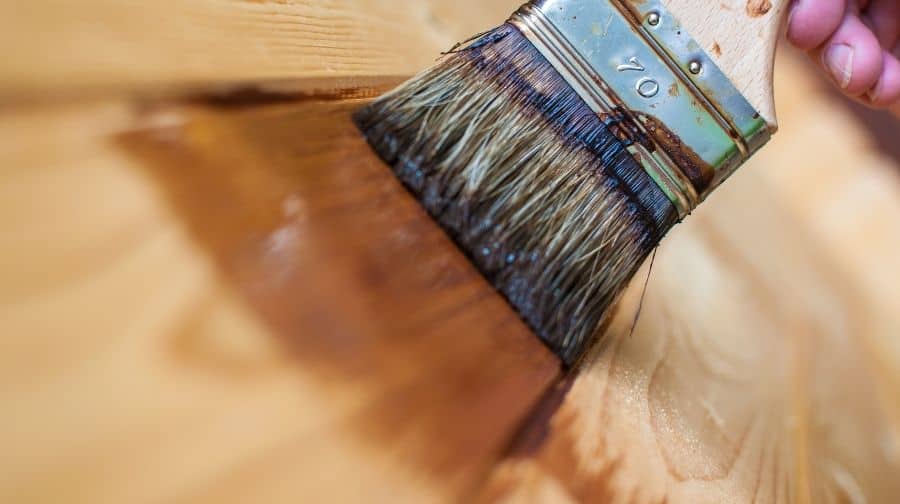
Water based stain is a type of semi-transparent wood stain that dries up quickly and cleans easily using soap and water. It’s explicitly used for staining a surface where the previous finish has been removed. Also, on bare and interior wood surfaces where a regular or oil based wood stain doesn’t work nicely.
Furthermore, another important factor that you can’t have in oil based wood stain is a variety of colors, while water based offers a wide range. What’s significant about this type of stain is that there’s no need for ventilation as there’s no dangerous fumes produced.
Let’s go through more details about water based wood stain, so you can make a better decision to choose between oil based and water based wood stain.
6 Key Benefits of Water Based Wood Stains
- First, water based stain lasts longer, protects the material against UV radiation, and helps to retain original colors.
- It minimizes the potential growth of a food source for mildew, algae, and mold, which means there will be more protection on the wood with the elimination of enemies of the wood that cause harm.
- It’s incredibly easy to clean as all you need is water and soap to mix together and apply using cloth or brushes.
- What’s surprising about this type of stain is that it doesn’t take much time to dry. Once you stain the deck, it won’t take more than 2 hours to start walking on the recently stained deck.
- It’s highly breathable, which means there will be no moisture trapped inside the wood to cause harm.
- You don’t need stripping and sanding if you’ve strained your wood with water based stain and are looking to renew the finish when it gets faded. All you need to do is clean the wood with water and soap, and it’s ready for the next staining.
Disadvantages of Water Based Stains
- You have to be an expert in staining, and if you’re not, you have to be extra careful with the application of water based stains because a single wrong step can ruin the entire process.
- If you over-apply such stains, it can lead to peeling, which is another indicator for the right application of this type of stain.
Discover 1,000 Hours Of Step-By-Step Woodworking Videos

It’s called Woodwork101. A database of detailed videos and blueprints in crystal clear, mouth-watering HD that will take you by the hand and show you that DIY home projects done the right way are easy, fun, and always of top quality… turning a dream into reality in a heartbeat. Getting you that perfect build each and every time.
How to Avoid The Top 7 Mistakes Made When Using Water-based Stains
Subscribe to General Finishes on Youtube
Spend 5 minutes watching this video and you too can produce a beautiful stain result with water-based finishes.
Whether you’re a pro or hobbyist using water-based stains, these are common mistakes we see and tips on how to avoid them. Not following these tips can cause blotchy, streaky finishes. If you’re working on your first project, start small and test your procedure so you can get comfortable before tackling a large project.
MISTAKE 1: Working a Large Project Alone Water-based stains dry faster than traditional oil-based stains. If you’re working on a large project like a bar top, have a second person helping. One of you should apply the stain while the other wipes the excess for the most consistent results.
MISTAKE 2: Working in Extreme Conditions Ideal conditions when applying stain are 70 degrees Fahrenheit and 50% humidity. NEVER work in direct sunlight or on hot surfaces. If you are working in hot or dry conditions, use up to 4.5 ounces of GF Extender per quart of stain to lengthen the dry time, as allowed by local regulations. In cool or humid conditions, allow extra time for the stain to dry, or speed up dry time by adding air movement with a fan or using an infrared lamp.
MISTAKE 3: Insufficient Project Prep Prepping raw wood or existing finishes with the correct cleaning and sanding schedule is critical. The process will vary for each wood species, substrate, and type of finish being used. Follow this link for a sanding tutorial for raw wood. https://generalfinishes.tips/Prep-San… Prepare existing finishes by thoroughly cleaning and scuffing, as described in the video https://generalfinishes.tips/Prep-San…
MISTAKE 4: Using the Wrong Applicator Picking the right applicator will allow you to work quickly and efficiently. When staining wood, follow this rule: The larger the surface, the larger the applicator. For small, flat surfaces, use a foam brush.For contoured surfaces, using a foam brush can slow things down. A good-quality bristle brush will make application easier and faster. For large surfaces, use a staining pad, pad applicator, or roller. Or spray with an HVLP, air-assisted airless, or airless sprayer.
MISTAKE 5: Not Applying Enough Stain Wood absorbs water-based stain differently than oil-based stain. It may take more product to saturate the surface and keep it wet. You know you have enough when you can write your initials in it, like this. If the stain is drying too quickly, immediately apply more to re-wet the surface. After 15-30 seconds, wipe away the excess.
MISTAKE 6: Not Using Absorbent Rags or Towels to Remove Stain Cheap paper towels and t-shirt rags can ruin a water-based stain job. They don’t absorb enough stain, they just push it around. Instead, use high-quality absorbent paper towels or cotton terry cloths to remove the excess. Keep your pressure light and even, and make the final wipe with the grain.
MISTAKE 7: Wiping Stain Out of Corners with a Rag Removing stain from tight areas with a rag is tedious and time-consuming. Instead, use a dry natural bristle brush. Natural bristles absorb water better than synthetic – even a chip brush can work for this. This 4-inch deck brush might seem too big, but it makes removing stain so easy. When the brush gets saturated, discharge the excess on a dry rag.
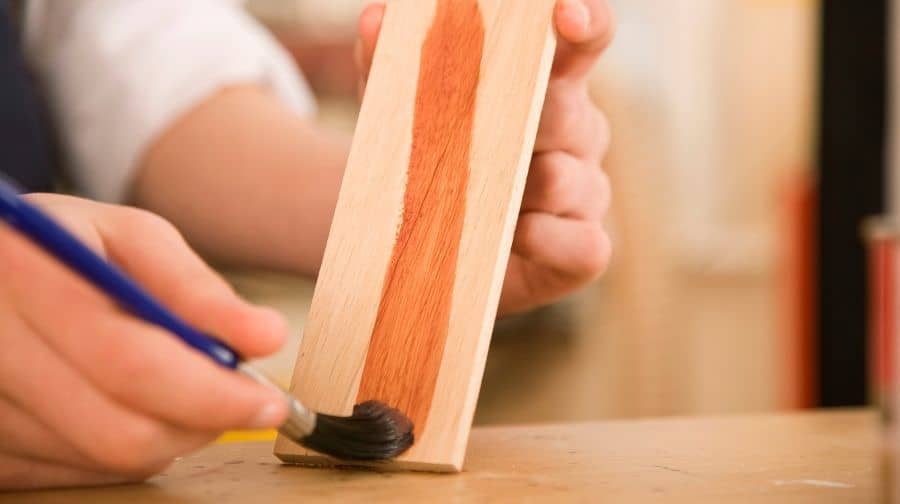
[Video] 3 Most Common Mistakes
When Setting Up Shop

A woodworking friend of mine shared this video by Ralph Chapman with me that helped him set up his workshop.
The video explains the benefits of Ralph Chapman’s guide about setting up an affordable workshop and avoiding the most common mistakes offers to anyone interested in woodworking.
Is Water Based Wood Stain Good?
Yes, if speed, protection, durability, variety and safety are your priorities, it’s the best choice for any type of wood, either for doors or decks. The stain maintains the quality of color comparatively longer, and it can be up to 3 years or more. What’s more exciting about the water based wood stain is its safety, which means it doesn’t produce dangerous fumes.
However, you have to be an expert for its application because it takes more expertise to precisely apply on the wood. A little mistake can ruin the entire staining process. Still, it’s a lot easier to apply because of its quicker drying, which takes only 2 hours as compared to oil based stain, which takes at least 48 hours.
When it comes to the protection of wood, the stain never lets moisture destroy the wood nor the algae, and other similar wood-affecting sources.
However, it may start peeling a lot sooner than oil based stains. Still, you get more color variety, which you can’t have in oil based stains. So, we can conclude it’s good for many reasons.
Is Water Based Stain as Good as Oil Based?
Water based stain is better than oil based stain in many factors, but oil based stain is preferred in a few cases. For instance, if you need more color choices, you should go for water based stains. In other cases, oil based stains protect better against exposure to wind, rain, and sunlight. Also, oil based stain is a lot easier to apply than water based stain, but it takes more time to get dry.
Meanwhile, water based stain is easy to clean and requires a mixture of soap and water to get the job done. You don’t need sanding either for renewing an already stained wood or getting a new coat. So we can conclude that it’s the best choice for many factors but isn’t as good as the oil based stain in a few, such as protection against wind, rain, and sunlight.
Subscribe to General Finishes on Youtube
What is the Best Water Based Wood Stain?
SamaN Interior Water Based Wood Stain
SamaN Interior Water Based Wood Stain is safe to use and doesn’t harm because it’s odorless, risk-free, and made using natural products. The stain is durable and contains high-quality products to ensure it lasts longer on the wood. It’s incredibly easy to use and clean, which helps beginners stain like a pro.
It’s necessary to get the best water based wood stain to get the desired finish and for increased durability.
Should I Use Oil or Water Based Stain for the Dining Table?
You should use a water based stain because oil based stain is meant to protect against rain, wind, and sunlight, you may not require it for the dining table because there’s no chance of exposure to any of these elements inside your home.
However, you can consider it if you expect a lot of spilling on the dining table and there’s no other protection. Still, you will get the most color choice options to match your furniture with a water based stain. Also, the application and drying are a lot easier, which makes your table ready to use within a few hours. So, considering these factors, you can make a better choice depending upon the situation you’re going through.
How Can You Tell If A Stain Is Water Based?
Get a cotton ball and a little rubbing alcohol. Dip the cotton ball into the alcohol and rub the cotton ball on wood. If the color gets lighter after ribbing the alcohol-dipped cotton ball, it’s a water based stain. Wait for a few minutes to let the alcohol applied dry to get the precise finish, so you can make a better decision. You can try this experiment on a small piece of wood so you don’t ruin anything.
Another way to judge the stain and tell if it’s water based or oil based is their application. But you may have to wait a few hours to ensure it. Apply the stain you have on a small piece of wood. Wait for at least three hours to let the stain dry naturally. If it gets dried up within three hours, it’s the water based stain because the oil based stain takes at least 48 hours to fully dry up.
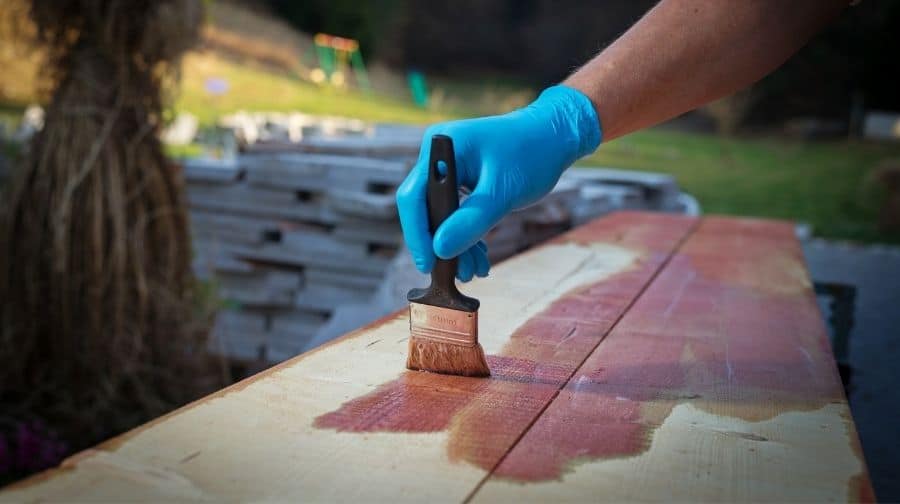
How Long Does Water Based Stain last?
On average, when the water based stain is applied along with polyurethane, it can easily last for at least three years. On the other hand, the oil based water stain lasts for five years when applied with polyurethane. However, it’s the average duration, but if you properly take care of the wood, it can last much longer.
For instance, the water based stain doesn’t have much protection against sunlight, so when it’s applied on a material that is never exposed to sunlight, it can last longer than three years.
Is Water Based Stain Waterproof?
The water based stain isn’t very waterproof, and you shouldn’t expect protection against rain and water. However, if polyurethane sealant is applied, you can expect a little waterproofing. Oil based stain is the best choice to protect your wood against water.
Does Water Based Wood Stain Smell?
Water based wood stain is not flammable and doesn’t have harsh odors or fumes.
If your water based wood stain smells bad, there’s a solution you can try. Add activated charcoal or baking soda to the stain to eliminate the odor.
How Do You Apply Water Based Stain?
Water based wood stain doesn’t differ in its application compared to other wood stains. Except for the fact that it requires more expertise, and any incorrect step can lead to ruining the entire staining process.
Here’s a guideline you can follow when staining such types of stains:
- Start with stirring the stain as the color pigments always settle down toward the bottom of the can and need stirring to mix for better application. It also helps in avoiding thickness and creates even application.
- Since this stain has the ability to dry too quickly, always apply more than usual stains because too little can dry quickly and won’t give even application. Use a brush or foam to apply the stain on the wood.
- Stain small portions on the wood to get precise results and stain each portion efficiently.
- Once you are done with staining, wipe down the entire surface using towel paper or a clean cloth.
- You may not require sanding a surface that has already been stained. Instead, direct staining can work too. However, sanding can make the surface ready for another coat.
- Multiple coats may be required when you’re using water based wood stain to get the desired color.
Subscribe to General Finishes on Youtube
Watch finishing expert Tom Monahan goes through all his tips and tricks to apply General Finishes water-based stain.
Do You Need to Put a Clear Coat Over the Stain?
You can expect double the durability by sealing the stain with another coat of sealer like polyurethane. For instance, polyurethane increases the long-lasting of the water based stain applied to wood to up to 2 more years than before. Finishing the wood protects it and helps in increasing durability. That’s why woodworkers often put a clear coat over the stain. Otherwise, you can leave it as well, but it wouldn’t be a great move.
A wood stained with water based stain without having sealant may not withstand external weather conditions. In that case, another clear coat helps in protection.
However, you CAN’T use shellac with water based stains. That’s the exception you should keep in mind.
Instead, go for polyurethane, which is found effective for water based stains. Also, make sure the sealer is compatible.
How Do You Prepare Wood for Water Based Stain?
The initial step in preparing your wood for the water based stain is sanding it. You may need medium-grade sandpaper of around 120. Later you may require a high grade of up to 220. To do so, sand the surface in one direction until you get the smooth surface ready to adhere and accept the water based stain. Keep removing dust side by side using a cloth or other suitable material.
Look for dried glue in the joint areas and make sure all the dried glue is removed once you’re done with sanding. Get a sock and rub it over the wood to feel the smooth surface to ensure the sanding is done efficiently. Once you complete the sanding process, wipe the wood to remove dust. Fill the holes to ensure there’s no blotchiness during the staining.
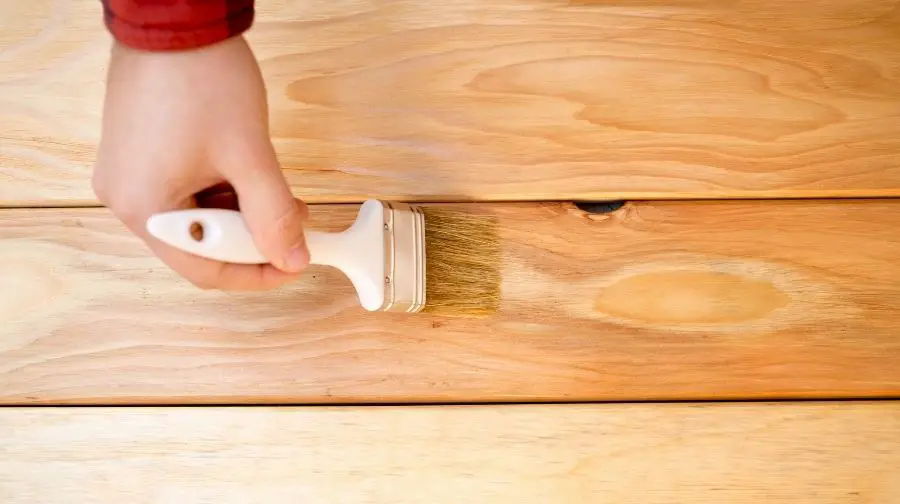
Can I Use Water Based Stain Outside?
Oil based stains provide better protection from the elements outside compared to water based stains. Water based stain is exceptionally good for cleanup because it only requires water and soap to do the job and you have a wide range of color choices. But when it comes to durability against outside weather conditions, you can expect better protection with oil based stain.
Oil based water stains withstand wind, rain, and direct sunlight to protect the wood. On the other hand, water based stain protects against algae and similar attacks only. Yyou can expect protection against moisture as well because it doesn’t let the moisture remain inside its coating, which could harm the wood. To conclude, water based stain for outside decks, doors, and railing isn’t recommended.
Can You Put Oil Based Stain on Top of Water Based Stain?
Yes, you can put oil based stain on top of water based stain. However, some protocols should be followed, such as cleaning the previous coating first to get ready for the new one. To do so, clean the surface first, sand if needed, and let the wood dry naturally before you apply another coat. Once you meet these requirements you’re good to put oil based stain or any other stain over water based stain to get the desired coating.
Most importantly, color choice is vital, which means you should consider darker colors over lighter ones to get the perfect results.
[Guide] How To Launch Your Woodworking Business For Under $1000
Click Here To View
If you’re considering turning your woodworking hobby into a part-time business check out this helpful guide on how to get started.
How Long Does It Take for Water Based Wood Stain to Dry?
Water based stain takes much less time to get dry as compared to the oil based stain. It takes only 1-2 hours to dry under ideal conditions. However, the time increases when the temperature is cold, and humidity is higher. In that case, it can reach up to 8-10 hours. Depending upon the type of water based wood stain, it can reach up to 72 hours as well. That’s the maximum drying up time you can expect from any water based wood stain.
You can manually increase the drying up time by making the conditions ideal. That includes good ventilation, higher temperature, and air movement with less humidity. Remember, always let the wood dry naturally, otherwise using artificial ways, you may not get the desired results.
Is Water Based Wood Stain Toxic?
No, water based stain is non-toxic, non-flammable and odorless. Which makes it completely safe for application on interior wood.
However, other traditional wood stain, when dry and their solvent evaporates, release a volatile organic compound or VOC, which can be unhealthy for the environment. But water-based is entirely safe.
Water-Based Stain
Subscribe to Bailey Line Road on Youtube
Is the Smell of Wood Stain Harmful?
Yes, the smell of wood stains can be harmful when inhaled. Waiting for it to fade can reduce the risk. You can make it more tolerable when using ventilation to reduce the strength of the smell.
Always stain within proper ventilation. To do so, use fans, open windows, and air purifiers to do the job. Common side effects are nausea, irritation of the eyes and throat, and dizziness.
How Many Coats of Water Based Stain Should I Use?
You need more coats when using water based wood stain vs oil based wood stain to get the same color. Typically, two coats are the minimum requirements even to get the lighter colors. For darker colors you need more coats, and it can be three and four to get the desired color.
Usually, it depends on the color strength you need, and then you decide to apply the amount of coats accordingly.
To do so, you have to wait between one coat and another coat to let the previous one dry naturally. Wait for at least one hour before you move to apply another coat. The experts recommend giving three to four coats if you’re using water based wood stain. Otherwise, it’s all your color choice, and you can decide accordingly.
How Do You Apply Water Based Stain to Plywood?
Application of water based stain to plywood is the same as with other wood stains on different materials. You have to start with sanding with medium-grade sandpaper and then move to a higher grade. Once you’re done with sanding, wipe off the debris out of the plywood. Apply the stain on the plywood in the direction of the grain to get efficient results.
Make sure you’re using a foam brush when staining the plywood with the water based wood stain. Once you’re done with staining, wipe off the excess stain to avoid blotchy areas. Let the plywood dry naturally and wait for at least 2 hours, depending upon the stain you’re using. At last, you can apply sealer like polyurethane to increase durability and protection.
Do You Need Wood Conditioner Before Water Based Stain?
Wood conditioner is a choice and not mandatory, but it does help to get an even level of stain and avoid blotchy spots.
The wood conditioner helps to adhere the stain evenly on the entire surface. As a result, there’s minimal or no blotchiness at all. The conditioner works by temporarily sealing and penetrating the wood filling it’s porous surface to even out the rate of stain absorption. As a result, the wood creates a much more uniform stain coat.
What Do You Seal Water-Based Stain With?
Polyurethane sealer is often used, which enhances the water based stain durability up to three years. Once you’re done with applying the water based stain and complete the drying process naturally, it’s time to apply the seal. It helps to increase the lifespan and improves protection against harmful factors, such as rain, wind, and sunlight.
Otherwise, you can apply different sealers, but shellac with NGR or water based stain is never recommended.
Polyurethane is highly recommended, and you have to make sure the sealer is compatible too. The sealer works by penetrating the wood pores and preventing water and other harmful substances from rusting the coat or causing rot.
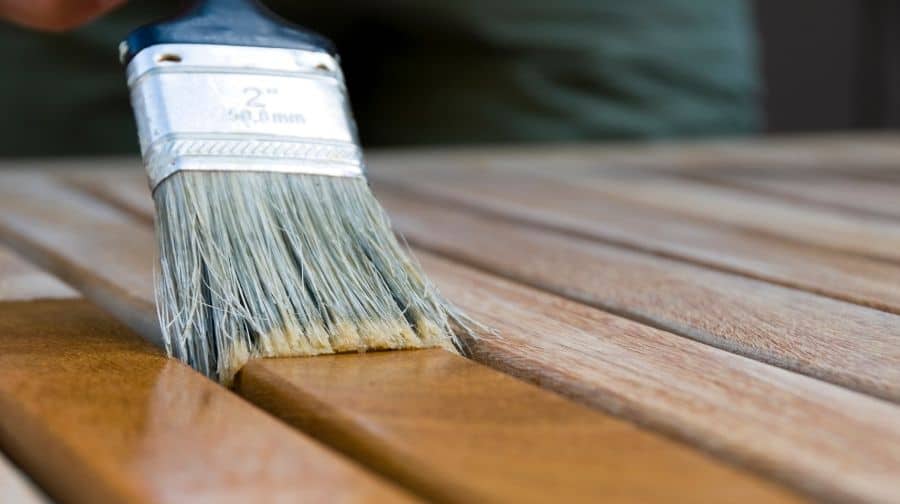
Is Water-Based or Oil-Based Stain Better for Pine?
Pine is hard to stain as you often end up with a lot of blotchy areas. In that case, the water based wood stain can be the best choice because it quickly evaporates after being applied to the wood and leaves less dark blotchy areas. On the other hand, the oil based stain can be a little tough on the pinewood, which is already hard to stain because of the blotchiness. Using a pre-stain wood conditioner can help reduce or eliminate a blotchy finish.
Another factor to consider while applying stain to the pine is the desired color. If you need a rough surface, then water based wood stain is an ideal choice. On the contrary, oil based wood stain can be a better choice to get smooth and dark colors on pine. So, depending upon your requirements, you can choose the wood stain accordingly.
How Do You Remove Water-Based Stains?
Removing the water based wood stain is incredibly easy.
Go through these simple steps to remove the stain from the wood:
- Make a mixture of baking soda and water.
- Apply the mixture on a microfiber cloth.
- Gently rub the cloth on the area where you want to remove the stain for up to 10 minutes minimum.
- Get another microfiber cloth that should be dry to wipe off the remaining moisture from the wood.
- Once you’re done with removing the water based stain from wood, apply furniture wax to re-seal the finish.
How Do You Remove Water-Based Stains from a Deck?
It doesn’t matter if it’s a deck or exterior furniture; removing water based stains is quite easy in each case.
However, you need to be accurate when going through these steps:
- Start with power washing your deck by applying water with pressure to remove dirt and mildew.
- Get a deck stain stripper even if you’re not able to completely remove dirt through power washing.
- Apply the stripper with paintbrushes and rollers to make the surface ready and easy to remove from the previous stain.
- After the deck striper, it’s time to get some deck brightener. Apply the deck brightener for a minimum of 48 hours before you apply the new stain.
- Wait for the prescribed period to ready the surface for another coat.
How to Remove Wood Stain
Subscribe to The Home Depot on Youtube
When Should I Use A Water Based Stain?
Water based stain should be the first choice for quick staining jobs as it doesn’t take much time to dry. Most importantly, when you’re looking for more color options, you can’t get that with oil based stain. Water based stain proudly offers a wide range of lighter to darker colors. Another reason to go for water based stain is its protection against food sources like algae and fungus, which it eliminates to keep the wood protected.
However, it isn’t the best choice to protect the wood against the wind, sunlight, and rain. Still, it doesn’t trap the moisture inside it because the water based stain is breathable, which offers a little bit of protection. Also, it’s a great choice when you’re looking to stain the already stained surface because you may not require sanding at all. Last, it can offer durability up to 5 years, which is quite appreciable.
Water Based Wood Stain Colors
Water based wood stain is best known for a wide range of color choices that oil based wood stains fail to offer. Since the first coat is highly light in color and adding more coats can make the color darker, you can get lighter to darker colors of your desire.
You have the following color choices in bright and bold colors:
- Crimson
- Tangerine
- Daffodil
- Green tea
- Hunter green
- Navy blue
- Island water
- Burgundy
- Sangria
- Coral
- Perfectly pink
- Cherry blossom
Subscribe to Woodworker’s Hardware on Youtube
Water Based Wood Stain Sealer
Polyurethane is a highly recommended water based wood stain sealer, and shellac is the most avoided sealer for such types of stains. The sealer helps the stain to increase it’s durability for up to 4 to 5 years. Usually, the stain may not last a year without this sealer. When polyurethane is used it penetrates deep into the pores of the wood, it offers more protection for a prolonged lifespan.
Water Based Wood Stain vs. Oil Based Wood Stain
The water based wood stain differs slightly from oil based wood stain in a few factors. Let’s go through some common factors to conclude the differences.
- Water based wood stain offers more color choices. You can get lighter to darker colors of your choice.
- Oil based wood stain lasts longer and can last for up to 5 years.
- Water based wood stain is preferred over oil based for quick drying because it takes around two hours, but oil based stain takes around 48 hours.
- It’s incredibly easy to clean water based stain using soap and water, but oil based stain takes more effort.
- Oil based water stain provides protection against wind, rain, and sunlight, but water based wood stain fails to do so.
- For larger areas like flooring and decks, oil based wood stain is used, and the water based stain is the best choice for interior furniture.
Comparing Clear Water Based and Oil Based Finishes
Subscribe to WoodWorkWeb on Youtube
Seeing the differences between clear coat finishes on woodworking projects can make a big difference in what you select as a finishing product. In this video we compare water based Satin Varathane against oil base Satin Varathane on Birdseye Maple.





